Newsworthy: Volkswagen yesterday revealed at the LA Auto Show that an all-electric 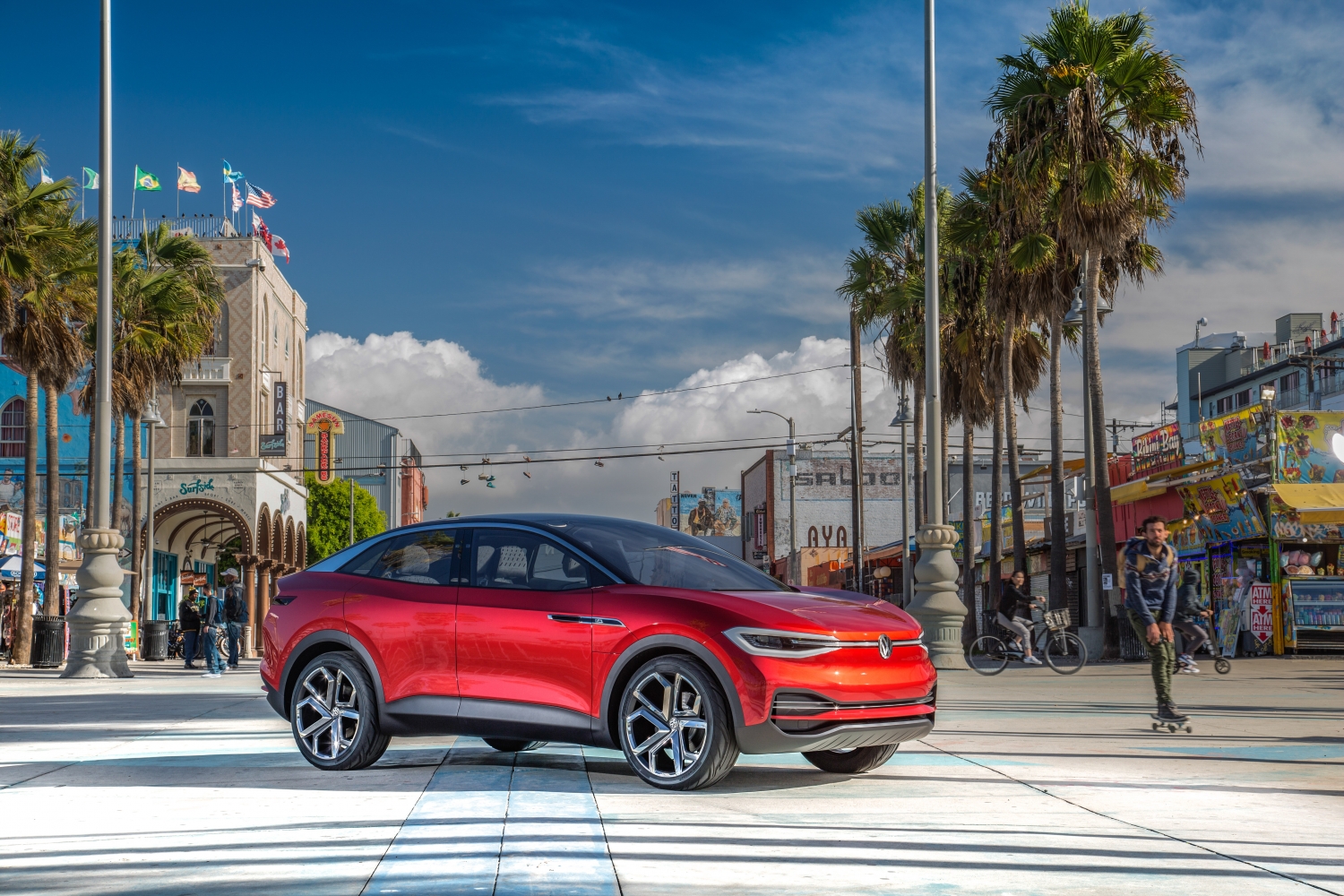 crossover based on its I.D. Crozz concept will be available in 2020. An 83-kWh lithium-ion battery pack with a pair of electric motors, one on each axle, will produce a combined 302 horsepower and an anticipated range of 300 miles. The I.D. Crozz will precede the I.D. Buzz microbus by about two years. The two were shown together with the I.D. concept car for the first time in North America…………… Two fledgling Tesla-competitors are facing contrasting scenarios, with Lucid Motors pulling ahead and Faraday Future struggling to raise funds. Lucid is moving its headquarters and doubling the size from Menlo Park to nearby Newark, Calif. The 1,000-horsepower Lucid Air will go into production in 2019 with a starting price of $60,000; and the automaker will be posting ads for more jobs in the near future. Faraday Future is facing a financial crisis next month, according to people familiar with the matter. A $400 million convertible note with a 12% interest charge, will become payable immediately if the company can’t raise the Series A round by December. There’s also about $100 million in unpaid bills as it works on paying off Chinese investors that had financed the debt, the sources said.
crossover based on its I.D. Crozz concept will be available in 2020. An 83-kWh lithium-ion battery pack with a pair of electric motors, one on each axle, will produce a combined 302 horsepower and an anticipated range of 300 miles. The I.D. Crozz will precede the I.D. Buzz microbus by about two years. The two were shown together with the I.D. concept car for the first time in North America…………… Two fledgling Tesla-competitors are facing contrasting scenarios, with Lucid Motors pulling ahead and Faraday Future struggling to raise funds. Lucid is moving its headquarters and doubling the size from Menlo Park to nearby Newark, Calif. The 1,000-horsepower Lucid Air will go into production in 2019 with a starting price of $60,000; and the automaker will be posting ads for more jobs in the near future. Faraday Future is facing a financial crisis next month, according to people familiar with the matter. A $400 million convertible note with a 12% interest charge, will become payable immediately if the company can’t raise the Series A round by December. There’s also about $100 million in unpaid bills as it works on paying off Chinese investors that had financed the debt, the sources said.
The future of fuel cell vehicles: Toyota Motor Corp.’s commitment to hydrogen fuel cell 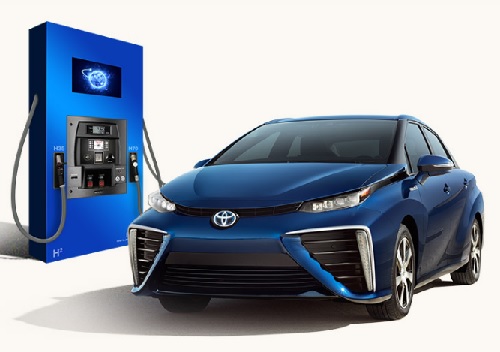 vehicles is going down he path of backing the Betamax over VHS in the 1980s, according to Reuters. While the points made are clear on electric vehicles reaching mass market adoption over fuel cell vehicles (FCVs), I think one part of the argument is inaccurate: hydrogen-powered vehicles won’t be going away like the Betamax.
vehicles is going down he path of backing the Betamax over VHS in the 1980s, according to Reuters. While the points made are clear on electric vehicles reaching mass market adoption over fuel cell vehicles (FCVs), I think one part of the argument is inaccurate: hydrogen-powered vehicles won’t be going away like the Betamax.
Here are a few points to consider:
OEMs onboard: While sales figures by Toyota, Honda, and Hyundai for their FCVs are slim – and the number of hydrogen stations are slight in comparison to other alternative fuels – automakers are not going to be leaving FCVs behind. These three automakers have broad plans for the technology in their future vehicles, and a few other major automakers such as General Motors, BMW, and Daimler, are making the investments as well. Elon Musk and Tesla won’t be joining the race, but that doesn’t mean the technology is finished.
California backing it: California Gov. Jerry Brown is dismissing President Donald Trump’s decision to leave the Paris climate change accord behind, along with likely softening the federal fuel economy and emissions standards. China seems to agree with him, welcoming Brown and CARB chair Mary Nichols over earlier this year for strategic planning meetings on zero emission vehicles; and China is now following that model. Keep in mind that FCVs are part of it, and California is not baking off supporting these vehicles and their needed fueling stations.
Toyota is covering all the bases: When reviewing Toyota’s decisions, keep in mind practicing the Japanese business philosophy of “kaizen,” or making continuous improvements in a corporate growth strategy. The management practice involves much longer phases than U.S. companies are used to. Toyota executives have clearly seen, since the 1990s, where government policy is going; along with a series of reports on increasing greenhouse gas emissions. The Japanese government has been pushing for FCVs and hydrogen stations and California, a few others states, Canada, and China, are going the ZEV route. Toyota’s product planning reflects the broad approach. It’s Prius Prime plug-in hybrid has been beating the Chevy Volt in U.S. sales lately with improvements made to battery range and other features; the Toyota Mirai has a long way to go but is getting substantial marketing support by the parent company; CEO Akio Toyoda is leading a team developing upcoming electric vehicle models; and even though sales of the Prius hybrid have been declining, the company isn’t backing away from building and marketing Toyota and Lexus hybrid models.

 and displays will emphasize the future of mobility, including autonomous, electrified vehicles. BMW will be showing the i8 Roadster plug-in hybrid two-seater that will go on sale in early 2018. It had been initially shown in 2014, and this one will have 358 horsepower and 330 miles of range with 14 in EV only. Porsche will show four models including the Panamera Turbo S E-Hybrid Sport Turismo that gets 680 horsepower. The 2017 Top Ten Automotive Startups Competition startups range from enterprise carpooling and in-air hand controlled devices, to electric motorcycles and analytics software for commercial vehicles. The “Smarter LA 2060” challenge will show what the city would be like of a major international sporting event such as the Olympics were to be held in the city in 2060……….
and displays will emphasize the future of mobility, including autonomous, electrified vehicles. BMW will be showing the i8 Roadster plug-in hybrid two-seater that will go on sale in early 2018. It had been initially shown in 2014, and this one will have 358 horsepower and 330 miles of range with 14 in EV only. Porsche will show four models including the Panamera Turbo S E-Hybrid Sport Turismo that gets 680 horsepower. The 2017 Top Ten Automotive Startups Competition startups range from enterprise carpooling and in-air hand controlled devices, to electric motorcycles and analytics software for commercial vehicles. The “Smarter LA 2060” challenge will show what the city would be like of a major international sporting event such as the Olympics were to be held in the city in 2060……….  announcing a pilot project to test out electric vehicles on the Uber platform in India. Hundreds of EVs will roll out in Delhi and Hyderabad starting in March, and other Indian cities will be under consideration. This announcement came days after Uber acknowledged that it had paid off hackers $100,000 over a year ago to destroy stolen data on more than 57 million customers and drivers. That’s brought up a few class-action lawsuits and a federal probe. Mahindra will be adding two new EVs to its fleet, with one being jointly developed with its South Korean unit, Ssangyong Motor Co, India’s national government continues to push forward on the plan for clean vehicles and energy, with some of it being deployed through public transportation. Uber and Mahindra will work with public agencies and private companies to establish charging stations, starting in Hyderabad.
announcing a pilot project to test out electric vehicles on the Uber platform in India. Hundreds of EVs will roll out in Delhi and Hyderabad starting in March, and other Indian cities will be under consideration. This announcement came days after Uber acknowledged that it had paid off hackers $100,000 over a year ago to destroy stolen data on more than 57 million customers and drivers. That’s brought up a few class-action lawsuits and a federal probe. Mahindra will be adding two new EVs to its fleet, with one being jointly developed with its South Korean unit, Ssangyong Motor Co, India’s national government continues to push forward on the plan for clean vehicles and energy, with some of it being deployed through public transportation. Uber and Mahindra will work with public agencies and private companies to establish charging stations, starting in Hyderabad. being charged in 30 minutes. An even faster charge may be coming, too. The heavy-duty truck will be able to go zero to 60 in five seconds, and can hit 60 mph in 20 seconds with an 80,000 pound payload. Musk said that it will make a real difference in the commercial truck market with its cost savings and driver comfort features. It will also save truckers a lot in maintenance costs, with Musk expecting the trucks to not break down until they pass the one million mile mark. The Tesla chief also said that the semi truck will be able to work in a three-truck convoy, reducing its cost per mile for the fleet down to $0.85 per mile, versus diesel being at about $1.25 per mile. The truck was revealed in a larger, long-haul version and a day cab without a sleeper. Attendees at the event were also able to view a new version of the Tesla Roadster roll out of the semi’s trailer. The sports car now has a removable glass roof. Musk said the Roadster will be the fastest car in production on the market with a maximum speed of 250 mph; and the ability to go from 0 to 60 in 1.9 seconds. It can go up to 620 miles on a single charge, a record for production-level electric vehicles………. Toyota is thinking about
being charged in 30 minutes. An even faster charge may be coming, too. The heavy-duty truck will be able to go zero to 60 in five seconds, and can hit 60 mph in 20 seconds with an 80,000 pound payload. Musk said that it will make a real difference in the commercial truck market with its cost savings and driver comfort features. It will also save truckers a lot in maintenance costs, with Musk expecting the trucks to not break down until they pass the one million mile mark. The Tesla chief also said that the semi truck will be able to work in a three-truck convoy, reducing its cost per mile for the fleet down to $0.85 per mile, versus diesel being at about $1.25 per mile. The truck was revealed in a larger, long-haul version and a day cab without a sleeper. Attendees at the event were also able to view a new version of the Tesla Roadster roll out of the semi’s trailer. The sports car now has a removable glass roof. Musk said the Roadster will be the fastest car in production on the market with a maximum speed of 250 mph; and the ability to go from 0 to 60 in 1.9 seconds. It can go up to 620 miles on a single charge, a record for production-level electric vehicles………. Toyota is thinking about 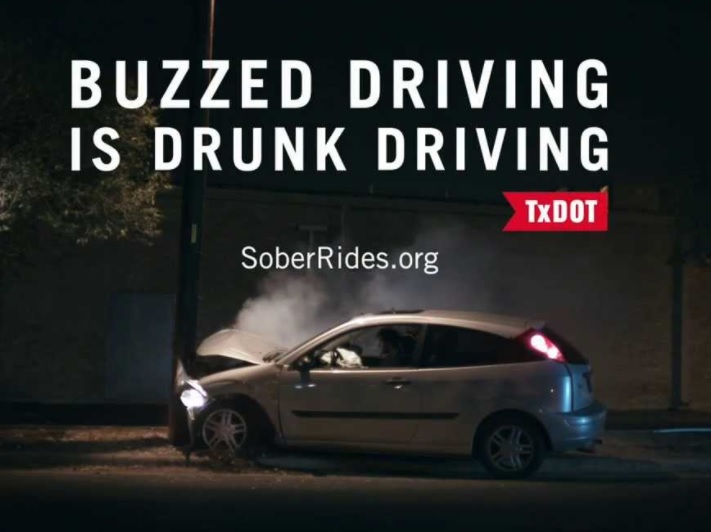 driving buzzed, and does it have anything to do with California and a few other states legalizing marijuana consumption? No, it has to do with a key issue state regulators and safety analysts bring up – the need to eliminate drunk driving and the necessity of bringing self-driving cars to U.S. roads. Buzzed driving refers to driving a car with a blood alcohol content (BAC) of .01% to .07%. That’s slightly under the .08% BAC standard used in most state’s drunk driving laws; but there’s been a great deal of concern that while .01% to .07% is legal for drivers, it can be just as dangerous as .08% or higher drunk driving for some of them. Self-driving cars are expected to dramatically reduce the highway fatality rate by taking away control of the car from drunk drivers being part of it. Drunk driving is still the leading cause of fatal crashes in the U.S. Last year was one of the worst ever, with an average of 20 people per day killed in DUI crashes. Safety experts have shared concerns about states legalizing marijuana and its possible side effects on road safety. That’s not measurable in a BAC standard used in drunk driving, but it may become part of state legislation in the future. Ride-hailing firms like Uber and Lyft have successfully tapped into concerns over drunk driving and see their rides as providing a solution to the problem. Uber and Lyft drivers have stories about riders expressing gratitude for their services, not having risked drunk driving after an evening at a night club or party. Mothers Against Drunk Driving (MADD) has been working with Uber in recent years to inform people that taking an Uber ride is much safer than getting behind the wheel after they’ve been drinking.
driving buzzed, and does it have anything to do with California and a few other states legalizing marijuana consumption? No, it has to do with a key issue state regulators and safety analysts bring up – the need to eliminate drunk driving and the necessity of bringing self-driving cars to U.S. roads. Buzzed driving refers to driving a car with a blood alcohol content (BAC) of .01% to .07%. That’s slightly under the .08% BAC standard used in most state’s drunk driving laws; but there’s been a great deal of concern that while .01% to .07% is legal for drivers, it can be just as dangerous as .08% or higher drunk driving for some of them. Self-driving cars are expected to dramatically reduce the highway fatality rate by taking away control of the car from drunk drivers being part of it. Drunk driving is still the leading cause of fatal crashes in the U.S. Last year was one of the worst ever, with an average of 20 people per day killed in DUI crashes. Safety experts have shared concerns about states legalizing marijuana and its possible side effects on road safety. That’s not measurable in a BAC standard used in drunk driving, but it may become part of state legislation in the future. Ride-hailing firms like Uber and Lyft have successfully tapped into concerns over drunk driving and see their rides as providing a solution to the problem. Uber and Lyft drivers have stories about riders expressing gratitude for their services, not having risked drunk driving after an evening at a night club or party. Mothers Against Drunk Driving (MADD) has been working with Uber in recent years to inform people that taking an Uber ride is much safer than getting behind the wheel after they’ve been drinking. making profits building and selling electric vehicles. General Motors CEO Mary Barra yesterday told investors at the Barclays Global Automotive Conference in New York that the company in 2021 will be launching a new, flexible platform for electric vehicle launches that will bring down costs and increase profits. The new EV platform will accommodate multiple sizes and segments, to be sold by different GM brands in the U.S. and China, she said. A new battery system will bring down costs 30% cheaper than the battery pack used in the Chevy Bolt, Barra said. The automaker will be building at least one million EVs a year by 2026, with most going into China to comply with new energy vehicle regulations. Last month, GM said it planned to launch 20 new electric vehicles by 2023, but did not provide details…………
making profits building and selling electric vehicles. General Motors CEO Mary Barra yesterday told investors at the Barclays Global Automotive Conference in New York that the company in 2021 will be launching a new, flexible platform for electric vehicle launches that will bring down costs and increase profits. The new EV platform will accommodate multiple sizes and segments, to be sold by different GM brands in the U.S. and China, she said. A new battery system will bring down costs 30% cheaper than the battery pack used in the Chevy Bolt, Barra said. The automaker will be building at least one million EVs a year by 2026, with most going into China to comply with new energy vehicle regulations. Last month, GM said it planned to launch 20 new electric vehicles by 2023, but did not provide details…………  recognized more than Warren Buffet, Jeff Bezos, Mark Zuckerberg, and Richard Branson combined. He’s been on the cover of
recognized more than Warren Buffet, Jeff Bezos, Mark Zuckerberg, and Richard Branson combined. He’s been on the cover of 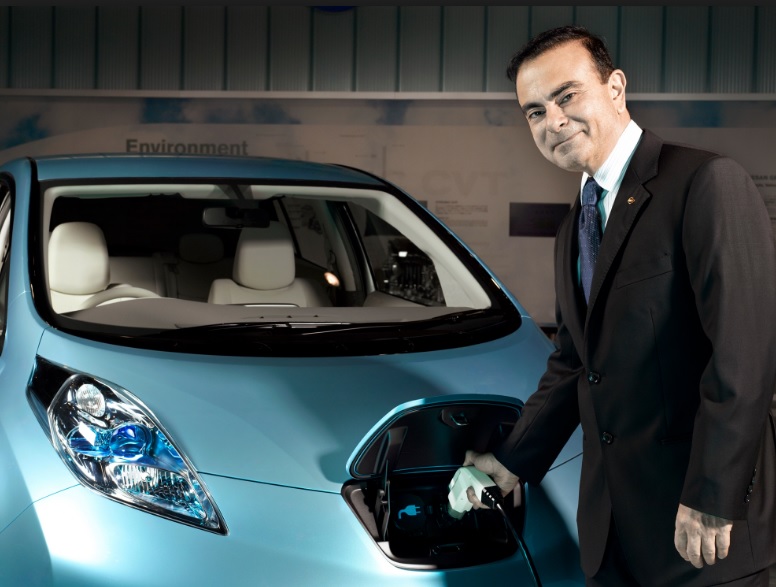 models using common platforms by 2022, according to CEO Carlos Ghosn. Plug-in hybrid models will also be utilized, coming from Mitsubishi’s experience with the Outlander PHEV. Two other utility plug-in hybrids will be coming to market over the next two years. The alliance companies have collectively already sold more than a half million plug-in electrified vehicles………….
models using common platforms by 2022, according to CEO Carlos Ghosn. Plug-in hybrid models will also be utilized, coming from Mitsubishi’s experience with the Outlander PHEV. Two other utility plug-in hybrids will be coming to market over the next two years. The alliance companies have collectively already sold more than a half million plug-in electrified vehicles…………. 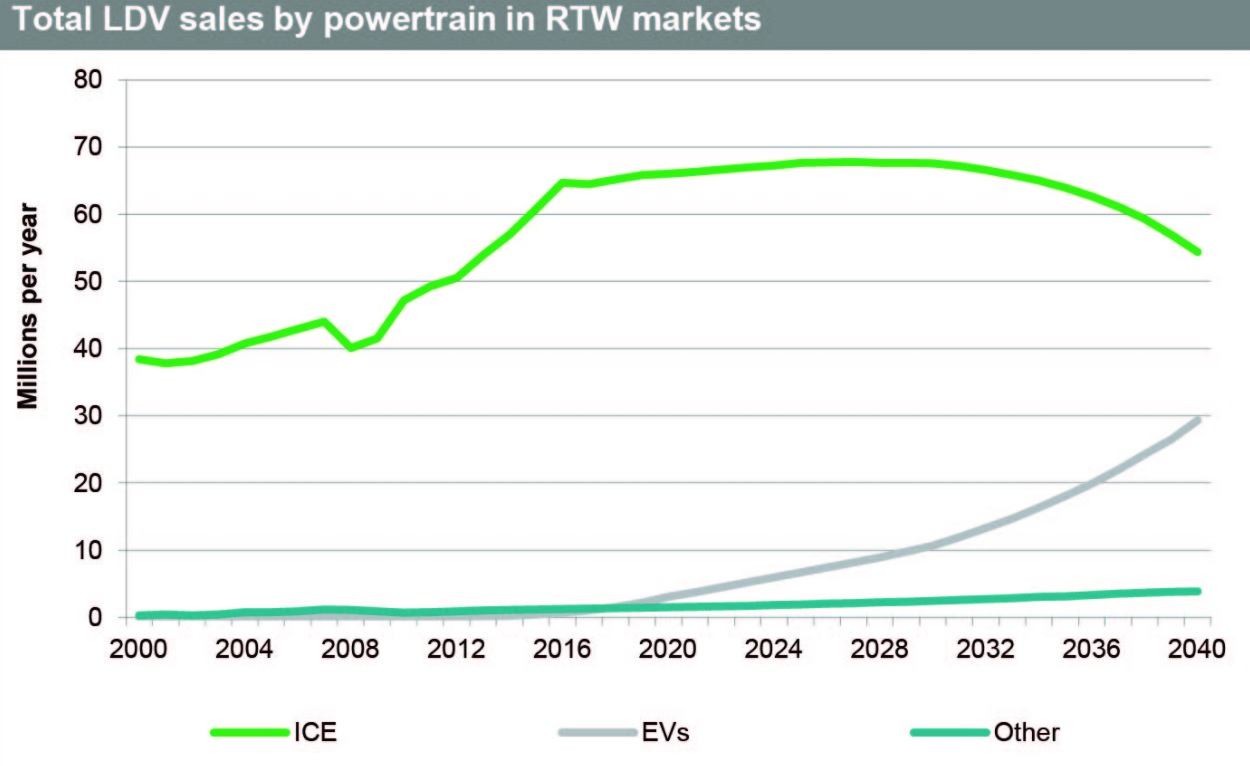 markets by 2040 – China, the U.S., Europe, and India – according to a new study by IHS Markit. You’ll notice that the percentage isn’t anywhere near 100% if fossil-fuel bans were to be enacted across these four markets. China, India, France, Great Britain, and other markets are considering banning gasoline and diesel powered engines entirely.
markets by 2040 – China, the U.S., Europe, and India – according to a new study by IHS Markit. You’ll notice that the percentage isn’t anywhere near 100% if fossil-fuel bans were to be enacted across these four markets. China, India, France, Great Britain, and other markets are considering banning gasoline and diesel powered engines entirely.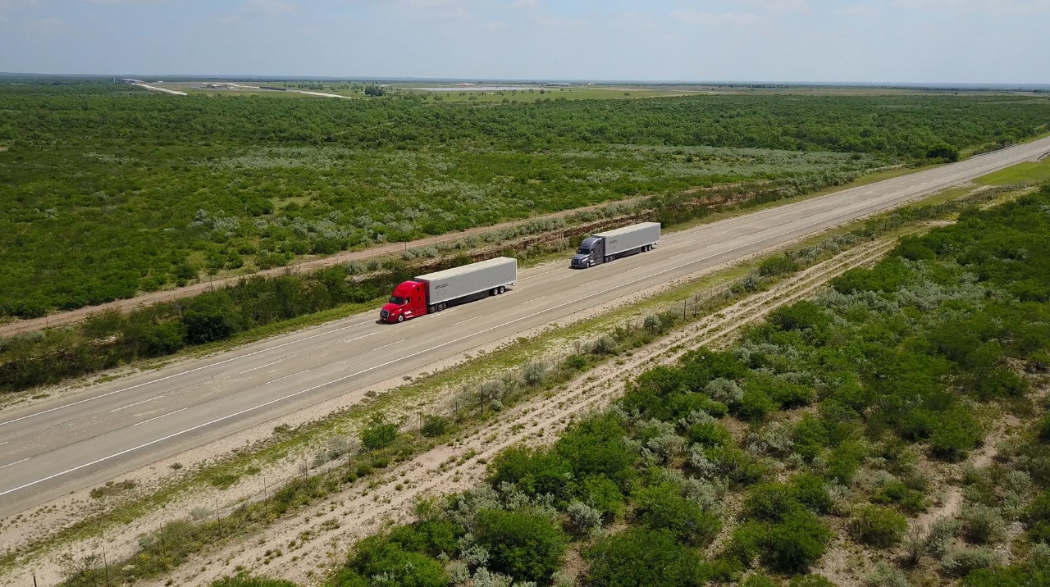 driving cars with huge investments being made for that to take place, according to technologists like Tesla and Embark. Trucking companies may not be as optimistic about the fast pace. Tesla will be showcasing its electric truck with some autonomous capabilities, while Silicon Valley startup Embark has been testing its autonomous trucking technology in a three-way partnership with Ryder and appliance giant Electrolux. CB Insights reports that companies will place about $1 billion in commercial truck autonomous systems this year, 10 times the level of spending three years ago……….
driving cars with huge investments being made for that to take place, according to technologists like Tesla and Embark. Trucking companies may not be as optimistic about the fast pace. Tesla will be showcasing its electric truck with some autonomous capabilities, while Silicon Valley startup Embark has been testing its autonomous trucking technology in a three-way partnership with Ryder and appliance giant Electrolux. CB Insights reports that companies will place about $1 billion in commercial truck autonomous systems this year, 10 times the level of spending three years ago……….  will
will 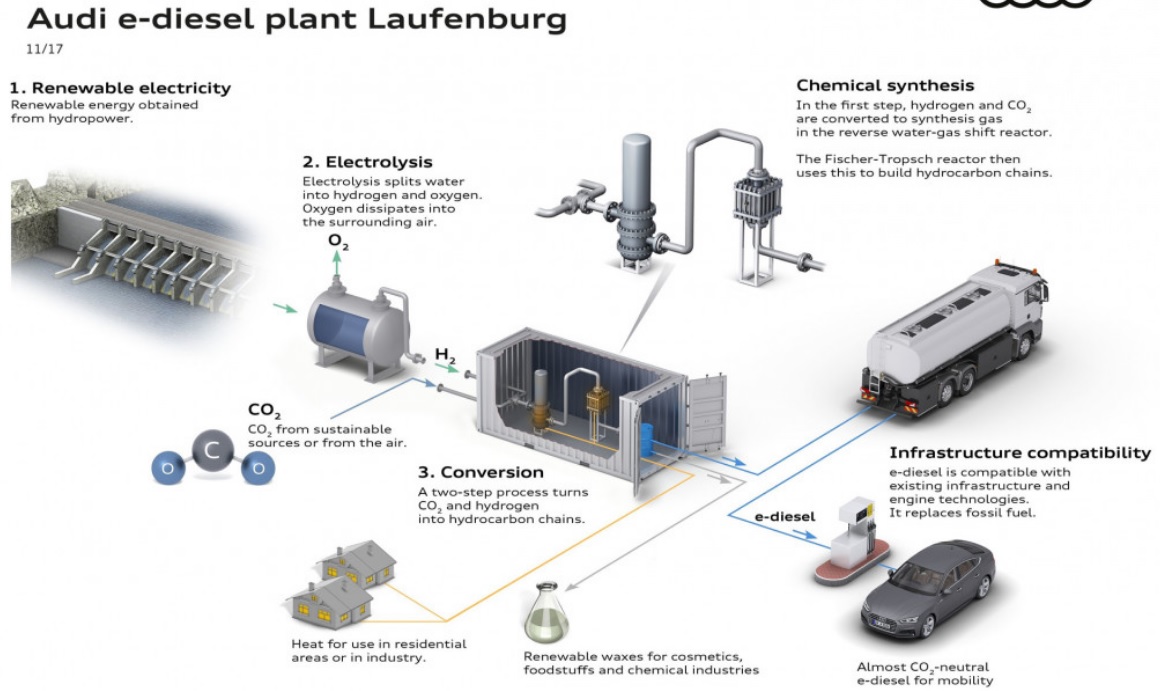 it’s calling e-diesel. Working with two partner companies, a plant will be set up in Laufenburg, Switzerland, that will be able to take excess energy coming from hydropower combined with CO2, converting it into a CO2-neutral diesel fuel. The CO2 being used will come from the air or bio waste gases. Construction of the plant will start in 2018 and should be finished by the end of that year, with the capacity of producing around 105,000 gallons of e-diesel per year. Audi’s e-fuels started in 2011 with plans to start energy production from wind turbines in the North Sea that would feed the renewable energy back into the grid. That led to turning renewables into liquid fuels that could power vehicles, with the first one being e-gas in 2013. The E-gas synthetic fuel, similar to natural gas, was followed by e-benzin in 2015, a synthetic fuel named after Germany’s term for gasoline, benzin.
it’s calling e-diesel. Working with two partner companies, a plant will be set up in Laufenburg, Switzerland, that will be able to take excess energy coming from hydropower combined with CO2, converting it into a CO2-neutral diesel fuel. The CO2 being used will come from the air or bio waste gases. Construction of the plant will start in 2018 and should be finished by the end of that year, with the capacity of producing around 105,000 gallons of e-diesel per year. Audi’s e-fuels started in 2011 with plans to start energy production from wind turbines in the North Sea that would feed the renewable energy back into the grid. That led to turning renewables into liquid fuels that could power vehicles, with the first one being e-gas in 2013. The E-gas synthetic fuel, similar to natural gas, was followed by e-benzin in 2015, a synthetic fuel named after Germany’s term for gasoline, benzin.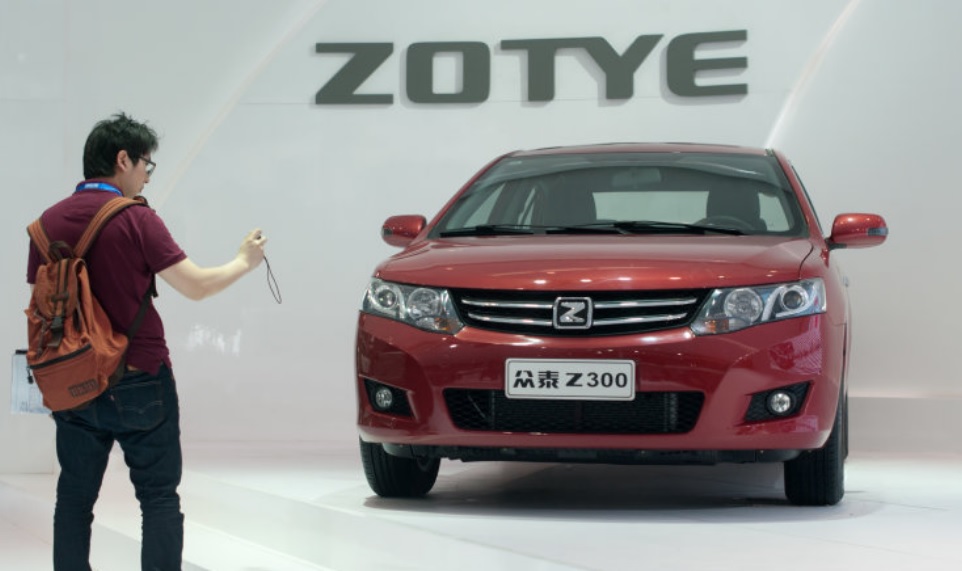 range of stylish and affordable all-electric vehicles for consumers in China under a new local brand. If it achieves regulatory approval, the new JV will design, build, market and distribute all-electric passenger vehicles for the Chinese market. The Detroit automakers already has JVs in place with Changan Ford Automobile Corporation, Ltd. and Jiangling Motors Corporation. Ford will continue working closely with each of its JV partners to develop and manufacture new energy vehicles to meet rising consumer demand in China during the impending electrification phase of the Chinese auto industry.
range of stylish and affordable all-electric vehicles for consumers in China under a new local brand. If it achieves regulatory approval, the new JV will design, build, market and distribute all-electric passenger vehicles for the Chinese market. The Detroit automakers already has JVs in place with Changan Ford Automobile Corporation, Ltd. and Jiangling Motors Corporation. Ford will continue working closely with each of its JV partners to develop and manufacture new energy vehicles to meet rising consumer demand in China during the impending electrification phase of the Chinese auto industry. Angeles Convention Center, Nov. 27-30, 2017. Debut vehicles will be shown right after at the 2017 LA Auto Show, which will be open to the public Dec. 1-10. The AutoMobility LA conference will feature more than 50 thought leaders across several panels, discussions, and keynote addresses. The Top 10 Startups challenge sets ten startups apart from thousands of newcomers, earns them a tremendous amount of media exposure, and places their products/services on AutoMobility LA’s global stage. Automakers are expected to conduct more than 50 world-class debuts at the event. BMW will be making nine debuts during its press conference, including two global debuts. Porsche will launch the global reveal of the Panamera Turbo S E-Hybrid Sport Turismo. Green Car Journal will announce the winner of the 2018 Green Car of the Year award. The 2018 nominated models include the Honda Accord, Honda Clarity, Hyundai Ioniq, Nissan Leaf, and Toyota Camry. The announcement will take place at the LA Convention Center on Thursday, Nov. 30, at 8:00 a.m. PST inside the Technology Pavilion.
Angeles Convention Center, Nov. 27-30, 2017. Debut vehicles will be shown right after at the 2017 LA Auto Show, which will be open to the public Dec. 1-10. The AutoMobility LA conference will feature more than 50 thought leaders across several panels, discussions, and keynote addresses. The Top 10 Startups challenge sets ten startups apart from thousands of newcomers, earns them a tremendous amount of media exposure, and places their products/services on AutoMobility LA’s global stage. Automakers are expected to conduct more than 50 world-class debuts at the event. BMW will be making nine debuts during its press conference, including two global debuts. Porsche will launch the global reveal of the Panamera Turbo S E-Hybrid Sport Turismo. Green Car Journal will announce the winner of the 2018 Green Car of the Year award. The 2018 nominated models include the Honda Accord, Honda Clarity, Hyundai Ioniq, Nissan Leaf, and Toyota Camry. The announcement will take place at the LA Convention Center on Thursday, Nov. 30, at 8:00 a.m. PST inside the Technology Pavilion.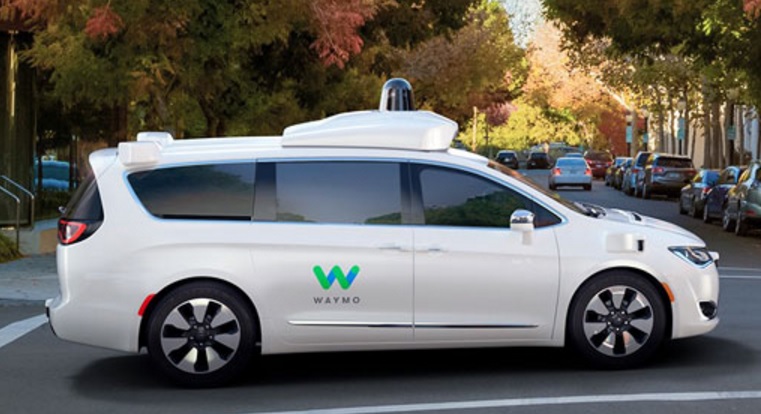 driving car technology. The federal judge in San Francisco hearing the trial has excluded Waymo’s damages expert, Michael Wagner, from the case; and has restricted use of financial evidence at the trial, according to a docket entry. Waymo claims that it has received damages worth about $1.9 billion in losses. Uber has denied using intellectual property that had allegedly been stolen by former Waymo engineer Anthony Levandowski. Waymo responded to the judge’s decision with a statement that it could still pursue full damages using “the same documents” relied upon by Wagner.
driving car technology. The federal judge in San Francisco hearing the trial has excluded Waymo’s damages expert, Michael Wagner, from the case; and has restricted use of financial evidence at the trial, according to a docket entry. Waymo claims that it has received damages worth about $1.9 billion in losses. Uber has denied using intellectual property that had allegedly been stolen by former Waymo engineer Anthony Levandowski. Waymo responded to the judge’s decision with a statement that it could still pursue full damages using “the same documents” relied upon by Wagner.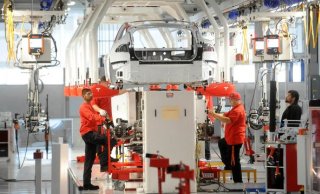 watched Model 3. Perbix, a maker of automated machines used for manufacturing, has been acquired by Tesla after nearly three years of working with the electric carmaker. Tesla has declined to disclose the cost of the acquisition and other details. Tesla will be expanding Perbix’ operations in the Minneapolis area, where the supplier is based. Tesla CEO Elon Musk has recently been making comments about the automation challenges holding up hitting the production timeline that had originally been set for the $35,000 Model 3. In other news, Jon Wagner, Tesla’s director of battery engineering, has left the company and is launching a battery and powertrain startup in California.
watched Model 3. Perbix, a maker of automated machines used for manufacturing, has been acquired by Tesla after nearly three years of working with the electric carmaker. Tesla has declined to disclose the cost of the acquisition and other details. Tesla will be expanding Perbix’ operations in the Minneapolis area, where the supplier is based. Tesla CEO Elon Musk has recently been making comments about the automation challenges holding up hitting the production timeline that had originally been set for the $35,000 Model 3. In other news, Jon Wagner, Tesla’s director of battery engineering, has left the company and is launching a battery and powertrain startup in California.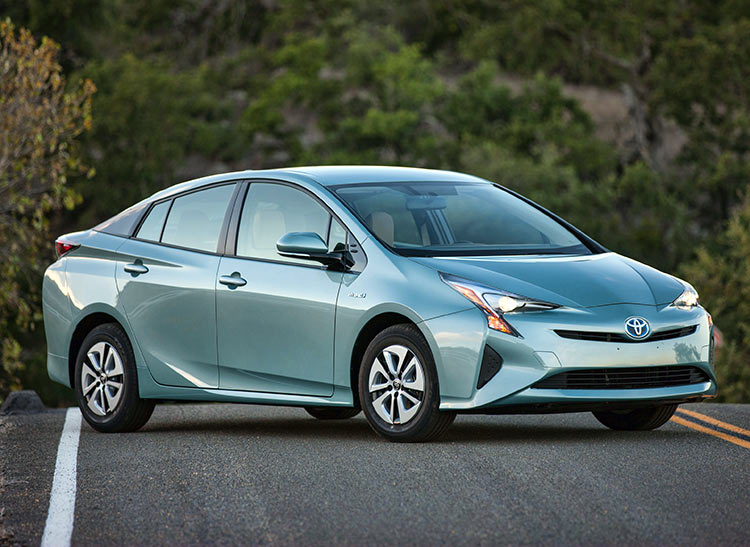 during October but down from September, which was the case with the overall new vehicle sales market. Sales were up for each category (hybrid, plug-in hybrid, and battery electric) year-to-date. Hybrids came in at 2.18% of U.S. new light duty vehicle sales in October, and plug-in electrified vehicles made up 0.996%. The Toyota Prius Liftback continues to fall out of place as the top selling hybrid in the U.S., coming in third place last month behind the Ford Fusion Hybrid and Toyota RAV4 Hybrid. It’s still the leading hybrid model for this year at 55,443 units sold versus 49,764 of the Ford Fusion Hybrid. The Prius Liftback is way down from last year, with 83,793 sold at this point in time during 2016. The Fusion Hybrid has almost doubled in volume form 26,699 sold through October 2016. The Chevy Bolt was the leader, by far, in plug-in electrified vehicle sales last month, with 20.7% of plug-in vehicle share. The Chevy brand took the first and third spots in total U.S. plug-in sales for the month. The Tesla Model S and Model X were way down in sales from September (75.6% and 73.5%, respectively), as the company struggles to prepare its car and battery factories for producing large volumes of the Tesla Model 3. For this calendar year, the Model S is No. 1 in U.S. plug-in sales, while the Model X is in the fifth position.
during October but down from September, which was the case with the overall new vehicle sales market. Sales were up for each category (hybrid, plug-in hybrid, and battery electric) year-to-date. Hybrids came in at 2.18% of U.S. new light duty vehicle sales in October, and plug-in electrified vehicles made up 0.996%. The Toyota Prius Liftback continues to fall out of place as the top selling hybrid in the U.S., coming in third place last month behind the Ford Fusion Hybrid and Toyota RAV4 Hybrid. It’s still the leading hybrid model for this year at 55,443 units sold versus 49,764 of the Ford Fusion Hybrid. The Prius Liftback is way down from last year, with 83,793 sold at this point in time during 2016. The Fusion Hybrid has almost doubled in volume form 26,699 sold through October 2016. The Chevy Bolt was the leader, by far, in plug-in electrified vehicle sales last month, with 20.7% of plug-in vehicle share. The Chevy brand took the first and third spots in total U.S. plug-in sales for the month. The Tesla Model S and Model X were way down in sales from September (75.6% and 73.5%, respectively), as the company struggles to prepare its car and battery factories for producing large volumes of the Tesla Model 3. For this calendar year, the Model S is No. 1 in U.S. plug-in sales, while the Model X is in the fifth position. in the past year, the company expects that demand for gasoline will likely reach its peak by the 2030s with owners switching over to electric vehicles ad traditional engines becoming even more efficient. Refined oil products and petrochemicals present a viable market growth opportunity, the company says. Examples include viable substitutes for asphalt as developing nations build more roads; or for polymers and chemicals used in production of cars, toys, and clothes. Shell will be doubling the size of its chemical operations by the mid-2020s with several new plants coming to Louisiana and Pennsylvania that benefit from access to cheap shale gas. The oil company wants about 20% of its revenue from its worldwide fuel stations to come from electric vehicle charging stations and from low-carbon fuels by 2025.
in the past year, the company expects that demand for gasoline will likely reach its peak by the 2030s with owners switching over to electric vehicles ad traditional engines becoming even more efficient. Refined oil products and petrochemicals present a viable market growth opportunity, the company says. Examples include viable substitutes for asphalt as developing nations build more roads; or for polymers and chemicals used in production of cars, toys, and clothes. Shell will be doubling the size of its chemical operations by the mid-2020s with several new plants coming to Louisiana and Pennsylvania that benefit from access to cheap shale gas. The oil company wants about 20% of its revenue from its worldwide fuel stations to come from electric vehicle charging stations and from low-carbon fuels by 2025.